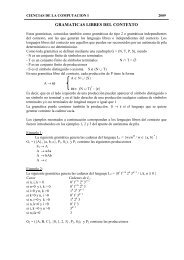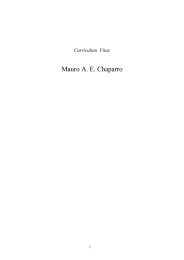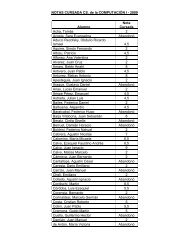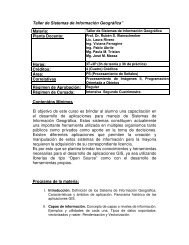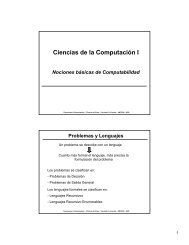Libro de Resúmenes / Book of Abstracts (Español/English)
Libro de Resúmenes / Book of Abstracts (Español/English)
Libro de Resúmenes / Book of Abstracts (Español/English)
Create successful ePaper yourself
Turn your PDF publications into a flip-book with our unique Google optimized e-Paper software.
Resumenes 71<br />
Mo<strong>de</strong>lo <strong>de</strong> red neuronal artificial aplicado a la estimación <strong>de</strong><br />
<strong>de</strong>nsida<strong>de</strong>s <strong>de</strong> zooplancton en ecosistemas <strong>de</strong> agua dulce<br />
Rosana Ferrati, Pablo Saavedra, Manuel Vargas Russo, Graciela Canziani<br />
Instituto Multidisciplinario sobre Ecosistemas y Desarrollo Sustentable<br />
Facultad <strong>de</strong> Ciencias Exactas<br />
Universidad Nacional <strong>de</strong>l Centro <strong>de</strong> la Provincia <strong>de</strong> Buenos Aires<br />
Tandil, Argentina<br />
rferrati@exa.unicen.edu.ar<br />
En un trabajo anterior (Vargas Russo et al., 2005) se presentó un<br />
mo<strong>de</strong>lo <strong>de</strong> Red Neuronal Artificial (RNA) que permitió <strong>de</strong>terminar<br />
concentraciones <strong>de</strong> clor<strong>of</strong>ila (Chla) y sólidos en suspensión (SS) a partir <strong>de</strong><br />
datos <strong>de</strong> firma espectral y <strong>de</strong> superficies <strong>de</strong> las lagunas obtenidos <strong>de</strong> las<br />
bandas 1 a 5 y 7 <strong>de</strong> imágenes satelitales LANDSAT 5 y LANDSAT 7<br />
previamente normalizadas. En este trabajo se propone un nuevo mo<strong>de</strong>lo <strong>de</strong><br />
RNA para <strong>de</strong>terminar la <strong>de</strong>nsidad <strong>de</strong> zooplancton presente en ecosistemas<br />
acuáticos lénticos a partir <strong>de</strong> la información obtenida <strong>de</strong> la red prece<strong>de</strong>nte y<br />
<strong>de</strong> la banda 6 <strong>de</strong> las mencionadas imágenes satelitales sin corrección<br />
radiométrica, para permitir incorporar los cambios ocasionados por la<br />
estacionalidad. El mo<strong>de</strong>lo se corrió tomando datos <strong>de</strong> siete lagunas <strong>de</strong> la<br />
región pampeana, con información recogida en las campañas realizadas<br />
<strong>de</strong>s<strong>de</strong> diciembre <strong>de</strong> 2004 a julio <strong>de</strong> 2005. Los resultados obtenidos permiten<br />
asegurar que la utilización <strong>de</strong> mo<strong>de</strong>los <strong>de</strong> RNA asociados a información<br />
obtenida a través <strong>de</strong> sensores remotos es a<strong>de</strong>cuada al momento <strong>de</strong> simular<br />
sistemas complejos altamente no lineales.<br />
An artificial neural network mo<strong>de</strong>l applied to the estimation <strong>of</strong><br />
zooplankton <strong>de</strong>nsities in freshwater ecosystems<br />
In an earlier work (Vargas Russo et al., 2005), an Artificial Neural<br />
Network mo<strong>de</strong>l (ANN) for the estimation <strong>of</strong> chlorophyll (Chla) and<br />
suspen<strong>de</strong>d solids (SS) concentrations from data on the spectral signature<br />
and shallow lake area extracted from bands 1 to 5 and 7 <strong>of</strong> previously<br />
normalized LANDSAT 5 and LANDSAT 7 satellite images, was introduced.<br />
Here we propose a new ANN mo<strong>de</strong>l for the estimation <strong>of</strong> zooplankton<br />
<strong>de</strong>nsities in lentic aquatic ecosystems using the information obtained from<br />
the prece<strong>de</strong>nt network and band 6, without any corrections in or<strong>de</strong>r to allow<br />
the inclusion <strong>of</strong> changes due to seasonality. The mo<strong>de</strong>l run taking data from<br />
seven shallow lakes in the pampean region together with data collected in<br />
field trips from December 2004 till July 2005. The output results allow us to<br />
assert that the use <strong>of</strong> ANN mo<strong>de</strong>ls associated to information obtained<br />
through remote sensors is a<strong>de</strong>quate for the simulation <strong>of</strong> highly non linear<br />
complex systems.<br />
Referencia<br />
• Vargas Russo M., Saavedra P., Dukatz F., Ferrati R., Canziani G. Diseño <strong>de</strong><br />
una herramienta computacional para la i<strong>de</strong>ntificación <strong>de</strong> indicadores<br />
naturales y socioeconómicos asociados a sistemas lénticos. V Seminario<br />
Internacional CYTED - XVII: Un enfoque integrado para la gestión<br />
sustentable <strong>de</strong>l agua. Experiencias en zonas húmedas. Buenos Aires, 6-8 <strong>de</strong><br />
abril <strong>de</strong> 2005.



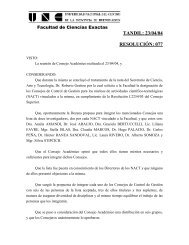
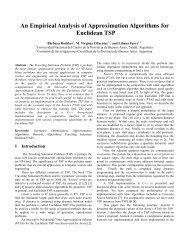
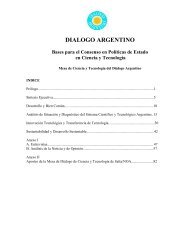
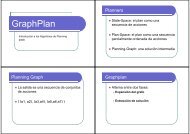
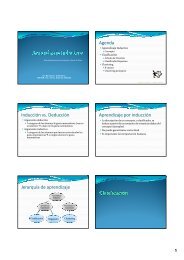
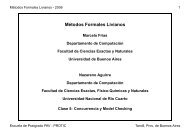
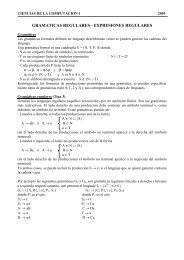

![Clase 13 [pdf]](https://img.yumpu.com/19616969/1/190x245/clase-13-pdf.jpg?quality=85)

